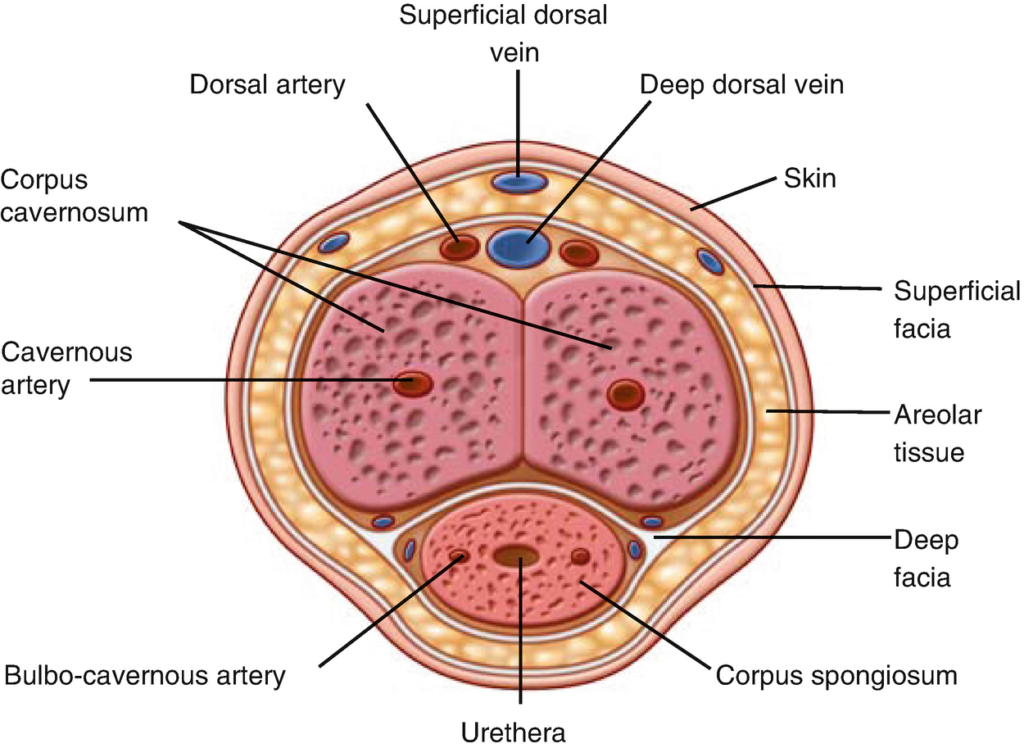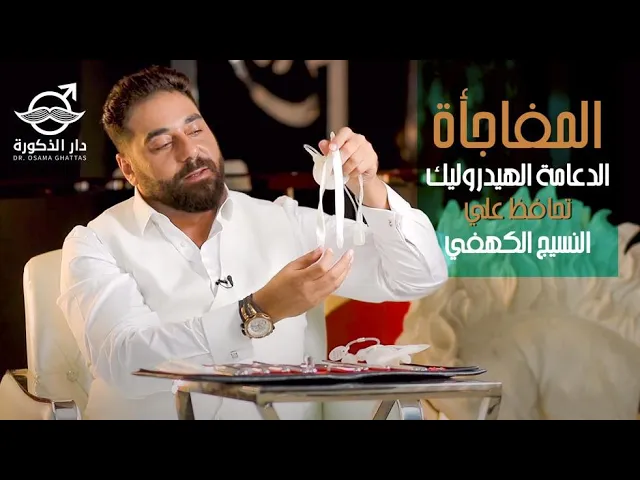Extracorporeal Penile Prosthesis Implantation
What is Corpus Cavernosum Penis?
The corpora cavernosa are two cylinders of spongy tissue enveloped in a fibrous tissue called tunica albuginea. They contain blood vessels that cause erections when they fill with blood.
The two corpora cavernosa lie along the penile shaft, from the pubic bones to the head of the penis, where they join above the urethra. They are covered in sensory nerve endings and vasculature.
The effect of erectile dysfunction on Corpus Cavernosum
The process of erection starts with blood flow to the arteries in the cavernous tissue which causes the cylinders to harden. To maintain the erection, the drainage system of veins must be constricted, preventing the blood form leaving.
One of the causes of erectile dysfunction is arterial stenosis which prevents the blood from flowing into the cavernous tissue. It can also be due to veno-occlusive dysfunction leading to venous leak or the inability to prevent the blood from flowing out. In Fibrosis of Corpora Cavernosa, the cavernous tissue loses its elasticity and resists expansion.

What is the best method to implant the penile prosthesis? Intra-corporeal or Extracorporeal
These two methods, which caused division amongst physician, will be reviewed below :
Extracorporeal Transseptal Penile Prosthesis Implantation :
The most common method used to implant penile prosthesis is inside the cavernous tissue not outside it
Implanting the prosthesis outside the cavernous tissue for the purpose of protecting it results in many complaints like:
- Decrease in penis size
- Decrease in erectile rigidity, effectively defying the purpose of the surgical implant
- Inability to engage in intercourse
- Curvature in the prosthesis
- In some cases, fracture of the prosthesis itself
While an extracorporeal prosthesis implant may produce apparently good results in the first few months after surgery, it deteriorates into the abovementioned negative consequences which are difficult to rectify.
Prosthesis implanting while keeping the cavernous tissue intact
Clinically and anatomically, there is no cavernous tissue. Fifty years ago, the first implant was introduced inside the cavernous tissue not outside it which in actuality is adjacent to the corpus spongiosum. This was achieved through an incision of 1.5 or 2 cm (about half an inch) in the penis and another incision of the same proportions in the corpus cavernosum through which the prosthesis is implanted.
Ending with an almost a 2 cm cut.
Can the extracorporeal implanting method keep the cavernous tissue intact?
On the contrary, this method requires a wider incision of almost 7 cm (2.8 inch). The tissue is then peeled aside to keep it intact effectively increasing the difficulty and the time of the surgery. The visible part of the penis has an equivalent length inside the pelvis. It is not practical to use the surgical retractors inside the pelvis
And thus, we conclude that the idea of an extracorporeal implanting method protecting the corpus cavernosum is false. It fooled some surgeons leading to perilous consequences for the patients.
Using this method is practically unethical. Instead of aiding the patient and guiding them to the most suitable solution, they are driven into harm’s way.
Dr. Arthur L. Burnett’s point of view on the extracorporeal method
We contacted Dr. Arthur L. Burnett, one of the leading professors of Andrology, to corroborate the validity of the before mentioned facts.
Who is Dr. Arthur L. Burnett?
Dr. Arthur L. Burnett is an Andrology professor in johns Hopkins university in America. He published more than 300 papers in the field of Andrology. He co-authored a major part of Campbell (Campbell Walsh Wein Urology) textbook, an invaluable resource for teaching and as a reference for erectile dysfunction research.
By asking Dr. Burnett about extracorporeal implants, he corroborated the dangers of such operation. Stating that; the protrusion of the prosthesis and the resulting infection are of the more dangerous side effects. And they make this operation primitive and obsolete. Sound reasoning does not support it.
Why would some people use extracorporeal implants?
There is another perspective on the use of the extracorporeal implant:
An idea was proposed to implant prosthesis of a lesser diameter than the corpus cavernosum. For example, a corpus cavernosum of 12 mm would normally need 12 mm prosthesis but this idea proposes using 10 mm and keeping 2 mm of tissue to maintain integrity of the corpus cavernosum.
The dangers and pitfalls of extracorporeal implants
While the effort and quest for development of new ideas are much appreciated, some complications and shortcomings of this technique include:
- The follow up period of the procedure is only one month. It is not an adequate period of time to evaluate the consequences.
- It was reported in a number of cases that the implant was not stable and it led to the fracture of the prosthesis
- Penis shrinkage.
- It was reported that the corpus cavernosum deteriorates none the less effectively defeating the purpose of the operation and necessitating another surgery.
Exploring the process of choosing a suitable prosthesis form the aforementioned perspective:
To implant prosthesis of a suitable size to the penis, the corpus cavernosum has to be widened. After a few weeks, the fibrosis renders the prosthesis size inadequate resulting in the problems discussed above.This idea cited a paper pertaining to applying hydraulic implants and not malleable ones and thus the citation cannot be accepted.
We cannot accept applying hydraulic implant methods on malleable implants as there is no sufficient validated proof that corroborates it.
Maintaining the corpus cavernosum is not an important factor in penile sensations. If the sensory nerves are kept efficiently intact, normal sensations are not affected.
Send A Message
Contact Us
Alexandria
Canary Tower – Gihan Circle – Gamal Abdel Nasser Street – Miami.
El Gehaz El Markazi Lelmohasbat building, 1st floor – Mohammed Fawzi Moaz street – Smouha.
Cairo
Fifth Settlement:
90th Street – CMC Mall – In front of Al-Nassam Hospital.
Sheikh Zayed:
Beverly Hills – Al Nada Clinics, Clinic No. 212, second floor – next to Al Nada Hospital.
Mansoura
Intersection of Banque Misr St. with the new railway under Al-Mawji Radiology.

